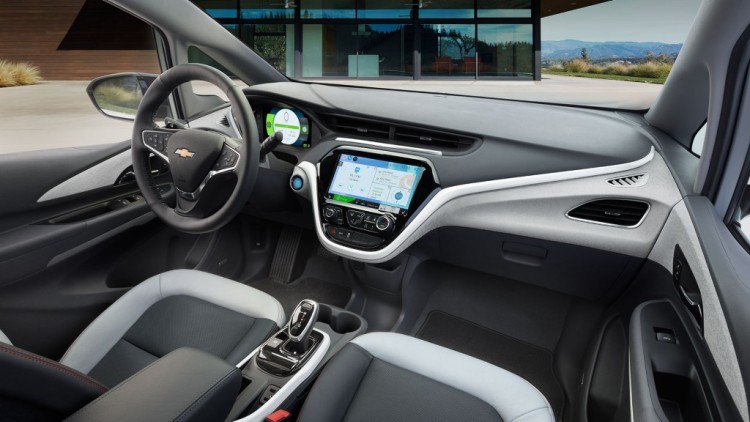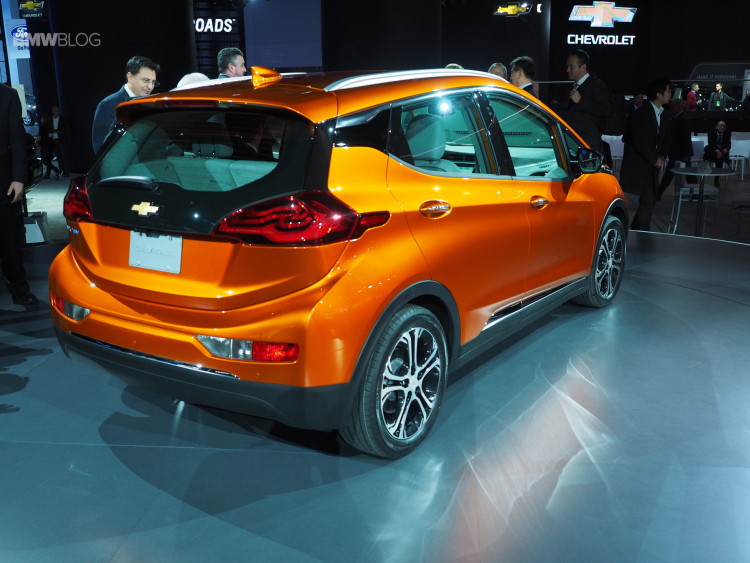BMW’s i3 has been fending off competitors and detractors since its inception. At the moment, the BMW i3 is sort of stuck in a class all by itself. While it has the same sort of range (just a bit more) than the Nissan Leaf, it’s significantly bigger, while also being lighter and faster. And the Tesla Model S has far more range and a far higher price tag. So the BMW i3 is kind of alone in its segment. However, that’s going to change quite soon with the addition of the new Chevy Bolt.
In almost all aspects, the upcoming Chevy Bolt will be the BMW i3’s closest competitor. It’s around the same size, has similar performance, similar interior space and will be priced similarly (about $38,000 for the Bolt and $42,400 for the i3). So when it comes out, the Bolt is what the i3 should be most afraid of. While the Bolt is still a few months away from being released, Car and Driver was able to take a drive in a nearly production-ready prototype to see what it was all about.

Judging by the outside, the Bolt has definitely been designed with the i3 in mind. Its large hatchback styling is clearly aimed at the i3 and it’s even designed with a sort of quirky, futuristic styling that makes it more interesting than good looking. Like the BMW i3, the Bolt isn’t pretty, but it’s visually interesting enough to keep your eyes on it. While it isn’t as outright funky as the i3, it’s close and far more appealing than the yawn-inducing Nissan Leaf. Want more evidence that the i3 was in the back of Chevy’s mind when designing the Bolt? Look no further than the fat floating D-Pillar.
It’s also about as quick as an i3, maybe even quicker. With 200 hp and 266 lb-ft of torque, the Bolt has the BMW i3’s electric motor beat, in terms of punch. However, it’s portlier than the i3, weighing in at around 3,600 lbs or so, compared to the i3 which tips the scales at just over 3,000 lbs. Chevy claims that the Bolt can do 0-60 mph in about seven seconds and probably just a bit under. That would actually make it quicker than the i3, but we’ll find out for sure when it comes out. The Bolt also has two driving modes in its shift gate — “D” and “L”. D is for your standard driving, much like an automatic transmission would normally do. L gives you regenerative braking that allows for the sort of one-pedal driving we love in the BMW i3.
In terms of handling and ride, C&D claims it to be quite nice to drive. With steering that’s light, but quick and accurate, and suspension that does a decent job of blending comfort and handling, the Bolt is actually more fun than one would imagine a front-wheel drive EV to be. In terms of handling, the BMW i3 has a few advantages, such as significantly less weight and rear-wheel drive. However, the Bold is probably the next best thing at the price point.

It also has quite a bit of room inside. It’s open and airy, much like the i3’s cabin. While it isn’t as futuristic and minimalist as the i3’s, it’s funky and high-tech looking. Obviously, we can’t comment on interior quality, but it certainly looks better than most GM products. If there’s any real criticism of the Bolt’s cabin, it’s that Chevy played it a bit too safe. It is supposed to be an EV for the masses, so I get Chevy not wanting to go too crazy and wanted its customers to feel at home. But if they want to feel at home, they should have bought a Cruze. The Bolt is supposed to be techy and futuristic, but the cabin is a bit dull. Aside from the large screens, there’s nothing to signify that this isn’t the interior of any other Chevy econobox.
But the big thing everyone is waiting to here about is the range. Just how far can the Chevy Bolt go? According to the EPA, 200 miles. That’s considerably better than the new i3’s 114 miles and will likely be Chevy’s big selling point with the Bolt. It is impressive, though, and should get many EV fans very excited. From 240-volts, the Bolt will recharge 25 miles every hour. It will also fully charge from empty in about 9 hours. However, with a DC fast charger, it can do 90 miles every half hour. Still not as good as Tesla’s Supercharger, which can replenish 210 miles in 40 minutes, but good enough for most folks.

The Chevy Bolt is going to get some comparisons to the Tesla Model 3, being that they’re both going to be priced similarly and offer similar range. They’re also both American. However, the Bolt has one massive leg up over the upcoming Model 3 — it exists. While the Model 3 boasts impressive stats, they’re nothing but claims. The Chevy Bolt is right here, right now (sort of) and can actually fulfill its claims. So the Chevy Bolt is the BMW i3’s biggest competitor and both cars offer a pretty excellent EV package for the money.
[Source: Car and Driver]



































































